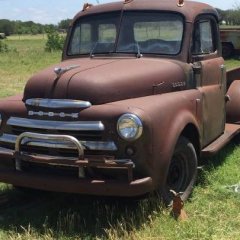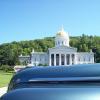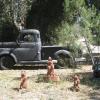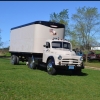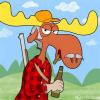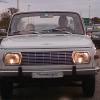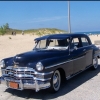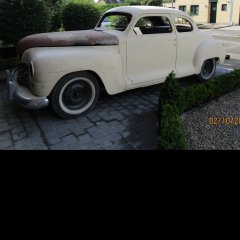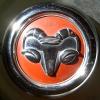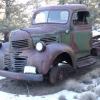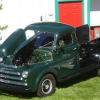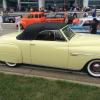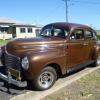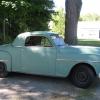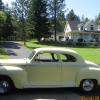Leaderboard
Popular Content
Showing content with the highest reputation on 11/10/2016 in all areas
-
I have zero experience on jetting these for that application, but tons working with Weber's. Number one problem is typically too much fuel pressure, they like no more than 2 1/2 to 3 psi. The float can only overcome the 3 psi, any more and you tend to go rich at odd times. Number two problem is incorrect float level, they are very sensitive to float level. Fuel has to cover all of the holes in the emulsion tube, otherwise you get weird troubles that act like a small air jet will help. We use to always start out with something in the area of 200 for air jets and 120 for mains and work from there. Primary idle jet should run well with the mixture screw at 1 1/2 turns, if you need more turns out you should try a bigger jet, less turns, smaller. Secondary idle jet is just about transition from primary to secondary, just about anything should work and some Weber's don't even have one. You can usually make any emulsion tube work with the right combination of air and main jets. http://www.webercarbsdirect.com usually has all the jets and are good folks, local VW shops can often help too. I can't imagine why you would want different jetting between front and rear carbs. Best books ever on Weber's are " Weber carburetors by John Passini - Theory, Tuning and Maintenance ", hard to read, very "English", but the best info I have ever seen. Some carbs have brass floats, some foam, watch out for a heavy float with foam ones, that can lead to hard to find troubles. Do the two carbs have the same internal venturi diameters? This is usually cast into the body on the outside of the throats, you should see something like 23 on the primary and 27 on the secondary, that is the internal diameter in millimeters. If they don't match, I doubt you'll ever get it to run correctly. Also make sure they have the same auxiliary venturi sizes, that is the bar that runs across the throat with the tube in it. They should be marked 3.5, 4 or 4.5, that is the minimum cross-section of the passage in the arm. If they don't match you will be transitioning from the idle circuit to the main circuit at different times. You will likely find more info on the DAT, DATR, DMTR series carbs which are very similar. Hope this helps!2 points
-
Finally the AoK George Asche Jr Ltd Edition Intake for the all 23 1/2" USA flathead Mopar engines has been completed and is in production. The pictures below has prototype linkage for the 1933-1938 Cars and all trucks and power wagons. You may notice that the left carb linkage bar has been cut short, and is not hooked to the left carb. That is strictly for prototype purposes and the production versions have a longer bar That allows for a linkage bar to come down from each carb to the common rail. It does shows how the serial number and linkage block provides the spot for stock linkage components to be mounted and then integrated with the new AoK linkages. That is critical for the earlier cars and trucks. You will notice for this version we are using the outside "wings" for linkage mounts. For newer cars where we want the linkage rail mounted on the inside, there are inside "wings" that are drilled and the rail is then on the inside wings. The outside block will then just be the serial number plate. Early cars and trucks are different in that they are on the outboard side of the intake, but they also have different connection points for the carbs to the common rail as compared to later model cars.. George has the linkage working perfectly for the several different applications. If you are going to be using this on the truck or older car you would just use your stock brackets and the AoK linkage will just integrate with it, to give you the desired upgrade from the single to dual carbs. Oh yes, and hot debate on the name.. Our original intent was to have the writing read from the passenger side although you may notice it was reversed to be read from the other side. In the production version, we have got the writing of "AoK George Asche Jr Ltd Ed" turned around and in a different font than the prototype. There were a couple of minor changes to the prototype, including making the outboard linkage mounting block slightly bigger, changing the name and a couple of internal items. Today the 1st batch of production intakes are being poured. That process will continue for the balance of the week, they are heat treated and shipped to us. We need to have the casted intakes machined, tapped and threaded which should see the 1st intakes ready to ship in the next 4-6 weeks. * Dec 3rd note: That casting turned out to be 1 being cast with the slight change talked about above. That one was heat treated and shipped to us. We called back and said why did you just ship us only 1. The reply, they wanted to be really sure it was correct. They were given the go to cast a production run and more of our Big Block Triples which have been sold out for months. They have no been all cast and are off for heat treating on Monday. The intake has been a long time coming, even more so given the prototype was completed almost a year and a half ago. Now - down to the brass tacks as my Grandfather would have said - Cost ! Feb 8 2017 Were committed to the pricing for the 1st shipment as we feel customers have waited a long time patiently for the product and that was our original We will be repricing them upwards slightly as the development cost and the casting price has escalated well beyond where the estimates were when we started. Just the casting price is up 73% which is an increase in the price of the aluminum. For linkage, if customers want us to make them linkage, it will start at $150 and really depends on what linkage is required. By that I mean if a customer needs linkage for a 1933 Desoto, and if they don't have the linkage block tab, we can get that piece and will sell it at our cost, but it is a relatively expensive part. If the customer has theirs and most do, then we will clean theirs up and paint it for them at no extra cost. If its linkage for a 1946-48 Plymouth, then it is very straight forward. Built carter ball and ball carbs are $195.00 each and the will be Siamese twins, meaning they will be exactly the same in their venture, throttle bore sizing and jetting, with all new kits in them and if a customer buys the entire package, George will mount the carbs, linkage, adjust everything and the customer wont have to pay anything extra for that or the carb gaskets. * Note if you already ordered your intake with carbs, the price quoted you is still in effect, even though the cost of full rebuild kits just went up significantly. Shipping is extra and is at cost, or the customer can use their shipping preference and if they have an account utilize that. We don't charge for packing or handling. Our address is George Asche/Tim Kingsbury 1693 fertigs Road, Fertigs, PA 16364 I can be reached directly at Fargopickupking@yahoo.com and we will accept paypal if it is send via family and friends so were not paying the paypal fee as there is literally no margin on these 1st batch of intakes. We will also accept a cheque, money order or if your driving by, cash! A few notes: 1) We will also be receiving a small number of the AoK triple intakes for the Canadian 25 1/2" big blocks. They have been sold out for over a year now so if you were looking for one of those we will be able to ship finished triples by year end. . 2) Headers made from OEM exhaust manifolds are available for both the USA small blocks and the Canadian big blocks. The last picture is from my 1949 Plymouth Business coupe which has a Canadian 265 ci motor in it and the AoK Triple. Its the same basic look for either the 23 1/2" small block or 25 1/2" big blocks. 3) We now have a source for reproduction GMC (not the Chevy versions with major air restrictions). You can get replacement air filters for them and they are available in Chrome tops or Black. The Black versions are $125.00 and Chrome ones are $138.00. You can see them here in a video posted by Fred Buhay. 4) The Big Note to be aware of: We expect to be able to ship finished intakes early next week, but there is not some big pile of built carbs or linkage sets made up and ready to ship and George hand makes every piece of linkage and rebuilds every carb completely from top to bottom. So if your looking for linkage or carbs or both, on top of an intake, get your order in early as I expect to see a big back log in short order. To date we have note taken orders or money, but have put people on a waiting list. Everyone on that waiting list were alerted 48 hours ago and right now 1/2 of the 1st production run has been spoken for. There is no fear that we will be unable to get people intakes, but the question of when we can supply is potentially a question. Finally if you would like us to call you and answer questions about either intake, we are happy to. Just drop me an email to fargopickupking@yahoo.com with your phone number and when is a good time to contact you and George or I will give you a call. below is the AoK triple on my 1949 Plymouth Business Coupe.1 point
-
Speaking from experience this is what I did on my 49 with less miles but had been sitting for years. Pulled head, valve job, new valve springs and replaced a few valves, cut the head . 50, new rings stock bore just honed it, new rod bearings. Did this while the motor in the car. I'v driven this car 25m since this repair. Runs cool, 22 mpg, solid 40# of oil pressure. Your current compression #s seem ok, Id rebuild the carb, make sure its tuned up and drive it like a rental.1 point
-
Great job on making use of what's around. With that lathe you can reproduce and modify the parts as needed so your options are many. Hope you and your Boy have many hours of fun with whatever current project, The stories to tell for years to come at many events.That's what really matters anyway.1 point
-
O.k., today I have an amusing one: Tired speedometer pointer The pointer on the PT`s speedo [1] consists of a steel ring with a pointer peak. The ring is pressed onto a clear plastic disc which has got a center hole for the attachment to the speedo shaft. This disc had been shrunken over the years [2] with the result that the pointer unit dangled like a lambs tail. Since I planned to clean the speedo anyway, I wanted to fix the disc at that point of time. Unfortunately the disc was so brittle, that it immediately broke in two halves [3] when I tried to reassemble it. A replacement piece was needed… When walking around through my home to look what material could taken, I saw that lonely children flashlight in the shelf... I only had to drill a center hole into the flashlights plastic lense, diameter and thickness had the perfect fit [4 & 5]. .... Of course, I had to buy a new flashlight for my son, but since the new one was much better, Dad AND Son were pretty happy !1 point
-
Big Thank You to all who have served to give me my freedom!!!!!!!!!! God Bless America!1 point
-
1 point
-
Now that's funny!!! You guys are a riot. I'm sure glad all of you have a sense of humor, it makes life a lot more interesting, as shown here, and it makes it a lot more fun, too. Thx.1 point
-
1 point
-
What does it mean when I stand sideways in the wind and I hear whistling?1 point
-
Wow!!! I had no idea that my question would generate such great dialogue. Dpollo's correct about vacuum, and what it is, and what it isn't. To expound upon his initial thoughts - vacuum's a space devoid of matter. a vacuum, or "free space", is any space where the gaseous pressure is lower than atmospheric pressure. In quantum physics, even if all matter could be removed from a given space, it still wouldn't be totally empty due to vacuum fluctuations, dark energy, gamma rays, cosmic rays, neutrinos, and other such phenomena being present within that given space. now, whoda thunk that a question about a fuel pump would generate such thoughtful discours. is this great - or what? Thank you everyone!!!!1 point
-
Fabricating is oft the need for parts. Keep up the good ideas for plan B, C, D, or E. You can computer snoop for anything. Soory about shipping charges. Those are some mighty clean parts too.1 point
-
1 point
-
1 point
-
If that cross member is bent upwards then them riveted brackets were holding the tire down onto the carrier...their spacing appears to allow for the rim offset1 point
-
Actually, a ¼" gap is something to consider, and the lip seal placement is important. From an engineering standpoint I'd be wondering what is causing it to stand proud and is there a remedy. It certainly could be that all of the associated parts stack-up to that position and perhaps w/o some machining it is what it is, but personally I'd be concerned about the seal.1 point
-
1 point
-
It's not so much the 1/4" gap that has some concerned, it's that the seal lip just barely goes over the sealing area on the spindle. I'm talking not much more than a 1/16" coverage. If the hub was just and 1/8" deeper on the inboard side it would allow for better seal contact.1 point
-
There needs to be a gap between the new hub and the Scarebird bracket. Caution. These brackets are left and right handed and must be put on correctly as per instructions with the correct side facing in. After the hub is all the way in the nut must be not be overly tight and backed off to the nearest cotter pin location. This 1/4 inch gap is much adeau about nothing.1 point
-
I have had 4 wheel disc brakes on my Oz 1940 Dodge since the mid 1970's.......the front discs are an Oz Leyland PBR brand 11" vented disc, they stop well.........this issue that you guys refer to is because the original stub axles are machined for a drum brake which by its very design uses a fixed stamped steel backing plate that when bolted onto the stub axle provides weather protection to the stub axle, axle hub and grease seal...........disc brakes by their design or at least as a result of their adaption to another non OEM stub axle don't have a stamped piece of sheet metal providing this weather protection as generally the disc rotor sits hard against the inner bearing machined area with the grease seal riding on the original larger diameter seal surface........unless the seal is torn, cracked or in some way the neoprene lets water etc past its inner facing "face" there is no problem......I have seen over the years various disc brakes adaptions on various cars, mostly hotrods and some have indeed had sheet metal, etc to give some protection to the seal but in general as our cars are not going 4 wheel driving I wouldn't worry about this.........when installing the disc rotor make a mark where the oil seal runs and before the final installation clean, prepare and paint this area to stop any rust.............btw from the attached pic you can see that my caliper bracket is a circular piece of steel that provides a little extra protection than just a basic caliper bracket...........my Oz 2 cents worth.........Andy Douglas1 point
-
I put my scarebird on a couple of years ago. Still working on the car so don't have a ton of miles on it but have had the hubs off a couple of times now while working on other things. I do see that my hubs don't fit flush with the back of the spindle but have not had any problems with them. Make sure you slide the hubs on as far as they can go. Mine were a tight fit the first time and had to use the nut to snug them all the way on. I think the new seal was tight at first but they fit fine.1 point
-
1 point


